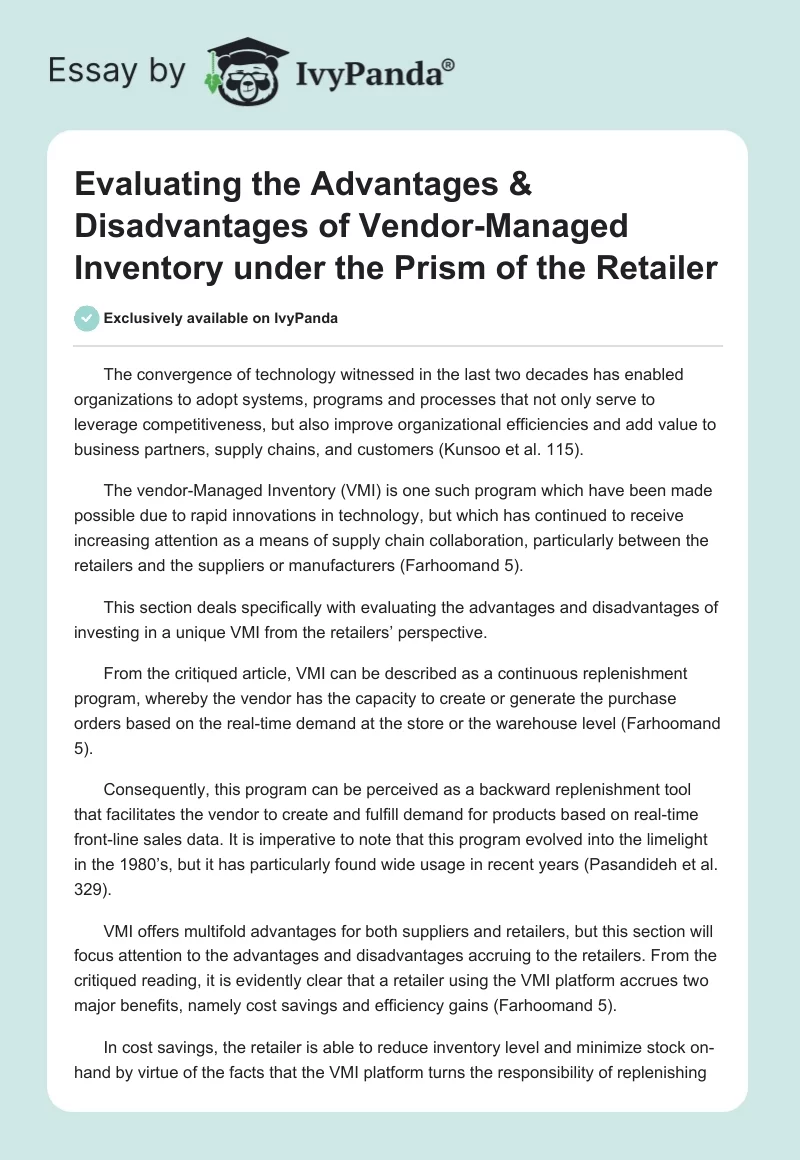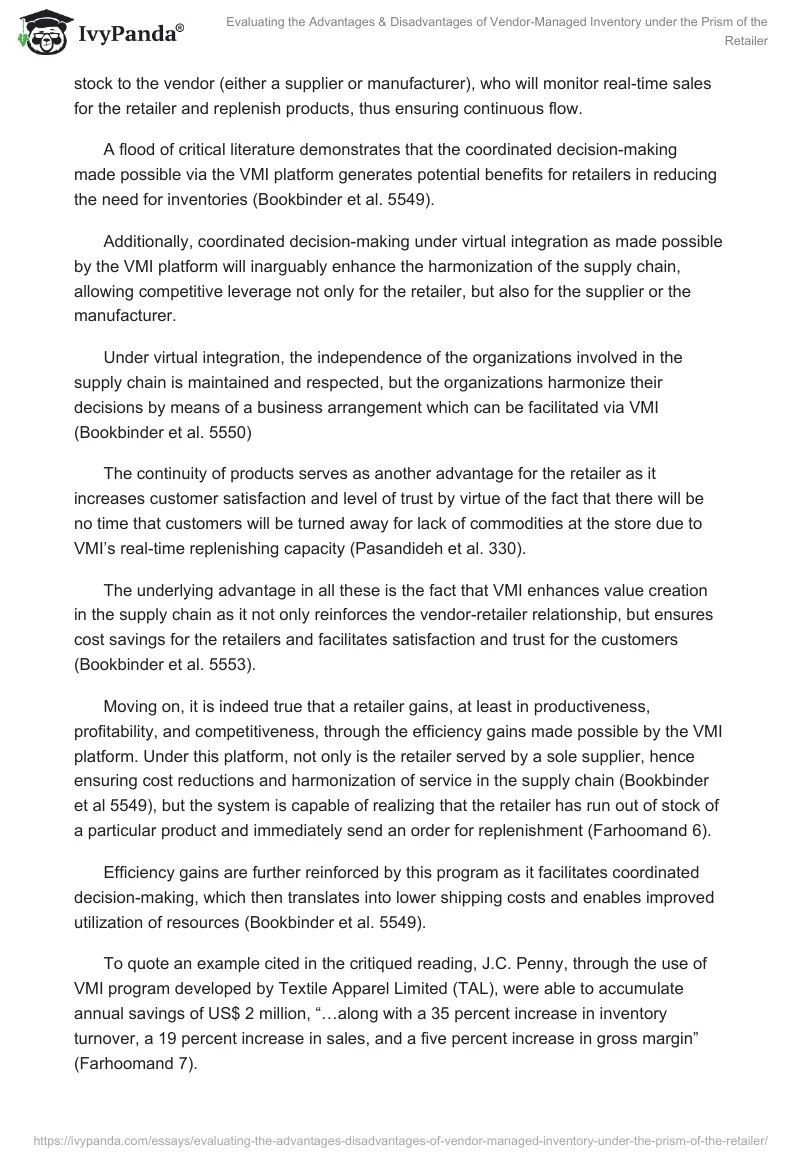The convergence of technology witnessed in the last two decades has enabled organizations to adopt systems, programs and processes that not only serve to leverage competitiveness, but also improve organizational efficiencies and add value to business partners, supply chains, and customers (Kunsoo et al. 115).
The vendor-Managed Inventory (VMI) is one such program which have been made possible due to rapid innovations in technology, but which has continued to receive increasing attention as a means of supply chain collaboration, particularly between the retailers and the suppliers or manufacturers (Farhoomand 5).
This section deals specifically with evaluating the advantages and disadvantages of investing in a unique VMI from the retailers’ perspective.
From the critiqued article, VMI can be described as a continuous replenishment program, whereby the vendor has the capacity to create or generate the purchase orders based on the real-time demand at the store or the warehouse level (Farhoomand 5).
Consequently, this program can be perceived as a backward replenishment tool that facilitates the vendor to create and fulfill demand for products based on real-time front-line sales data. It is imperative to note that this program evolved into the limelight in the 1980’s, but it has particularly found wide usage in recent years (Pasandideh et al. 329).
VMI offers multifold advantages for both suppliers and retailers, but this section will focus attention to the advantages and disadvantages accruing to the retailers. From the critiqued reading, it is evidently clear that a retailer using the VMI platform accrues two major benefits, namely cost savings and efficiency gains (Farhoomand 5).
In cost savings, the retailer is able to reduce inventory level and minimize stock on-hand by virtue of the facts that the VMI platform turns the responsibility of replenishing stock to the vendor (either a supplier or manufacturer), who will monitor real-time sales for the retailer and replenish products, thus ensuring continuous flow.
A flood of critical literature demonstrates that the coordinated decision-making made possible via the VMI platform generates potential benefits for retailers in reducing the need for inventories (Bookbinder et al. 5549).
Additionally, coordinated decision-making under virtual integration as made possible by the VMI platform will inarguably enhance the harmonization of the supply chain, allowing competitive leverage not only for the retailer, but also for the supplier or the manufacturer.
Under virtual integration, the independence of the organizations involved in the supply chain is maintained and respected, but the organizations harmonize their decisions by means of a business arrangement which can be facilitated via VMI (Bookbinder et al. 5550)
The continuity of products serves as another advantage for the retailer as it increases customer satisfaction and level of trust by virtue of the fact that there will be no time that customers will be turned away for lack of commodities at the store due to VMI’s real-time replenishing capacity (Pasandideh et al. 330).
The underlying advantage in all these is the fact that VMI enhances value creation in the supply chain as it not only reinforces the vendor-retailer relationship, but ensures cost savings for the retailers and facilitates satisfaction and trust for the customers (Bookbinder et al. 5553).
Moving on, it is indeed true that a retailer gains, at least in productiveness, profitability, and competitiveness, through the efficiency gains made possible by the VMI platform. Under this platform, not only is the retailer served by a sole supplier, hence ensuring cost reductions and harmonization of service in the supply chain (Bookbinder et al 5549), but the system is capable of realizing that the retailer has run out of stock of a particular product and immediately send an order for replenishment (Farhoomand 6).
Efficiency gains are further reinforced by this program as it facilitates coordinated decision-making, which then translates into lower shipping costs and enables improved utilization of resources (Bookbinder et al. 5549).
To quote an example cited in the critiqued reading, J.C. Penny, through the use of VMI program developed by Textile Apparel Limited (TAL), were able to accumulate annual savings of US$ 2 million, “…along with a 35 percent increase in inventory turnover, a 19 percent increase in sales, and a five percent increase in gross margin” (Farhoomand 7).
This statement demonstrates that VMI has the potential to not only increase the sales revenues of retailers through the efficiencies of scale and coordinated supply chain(Bookbinder et al. 5549), but it elevates gross profit margins due to its tendency to reduce unnecessary inventory (Pasandideh et al. 335).
Finally, in benefits, it can be argued that the VMI platform enables retailers to evaluate their performance measures as it oscillates around real-time ordering and selling to replenish stocks (Farhoomand 6).
Among the disadvantages, it is costly for small-scale retailers to utilize the platform due to the costs involved (Pasandideh et al. 338). Also, available literature demonstrates that some researchers and practitioners to date question whether VMI is beneficial to all the parties involved, with some suggesting that vendors are reluctantly forced in VMI relationships by powerful retailers.
While others are of the opinion that VMI is just a means to convey the risks involved in inventory management from retailers to vendors (Bookbinder et al. 5550). However, going by the reluctance exhibited by J.C. Penny when it was approached by TAL to try out the VMI program (Farhoomand 5), it can be argued that such assertions remain untested by theory and practice.
Works Cited
Bookbinder, James H., Gumus, Mehmet, & Jewkes, Elizabeth, M. “Calculating the Benefits of Vendor Managed Inventory in a Manufacturer-Retailer System.” International Journal of Production Research 48.19 (2010): 5549-5571.
Farhoomand, Ali. TAL Apparel Limited: Stepping up the Value Chain. Asia Case Research Centre, the University of Hong Kong. 2005.
Kunsoo, Han, Young, Bong C., & Jungpil, Hahn. “Information Technology Spillover and Productivity: The Role of Information Technology Intensity and Competition.” Journal of Management Information Systems 28.1 (2011): 115-145.
Pasandideh, Seyed Hamid R., Niaki, Seyed Taghi K., & Nia, Ali Roozbeh. “An Investigation of Vendor-Managed Inventory Application in Supply Chain: The EOQ Model with Shortage.” International Journal of Advanced Manufacturing Technology 49.1 (2010): 329-339.


